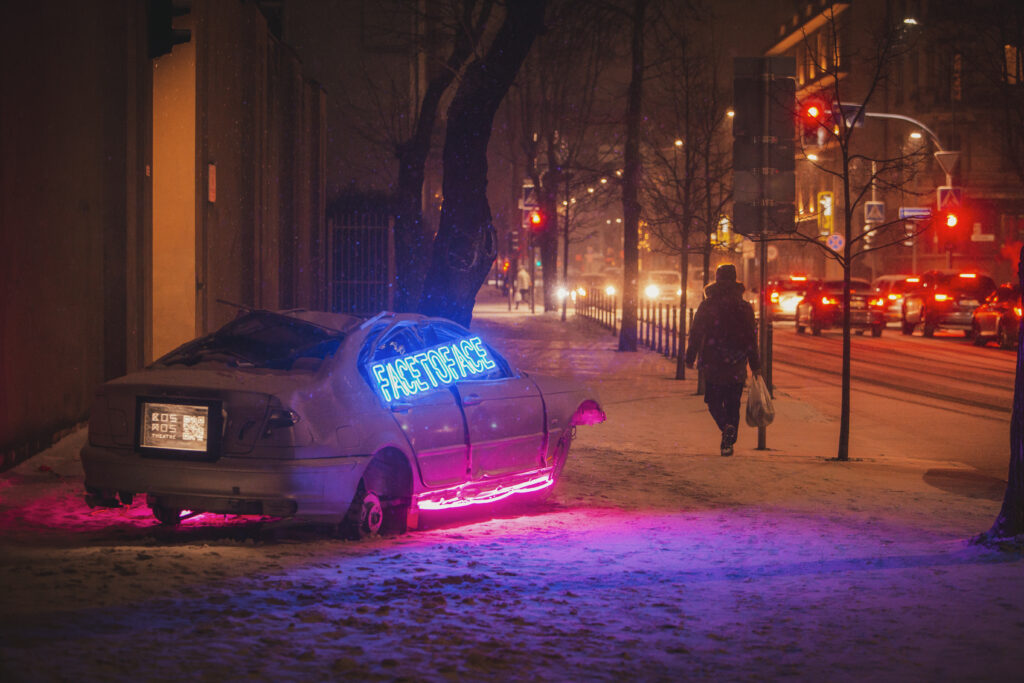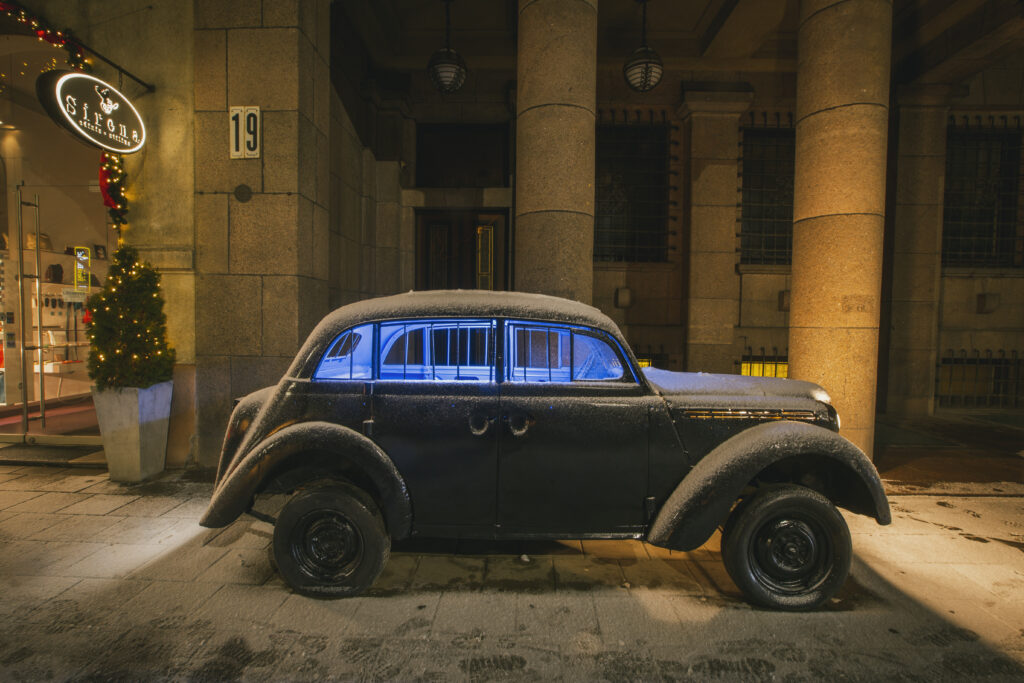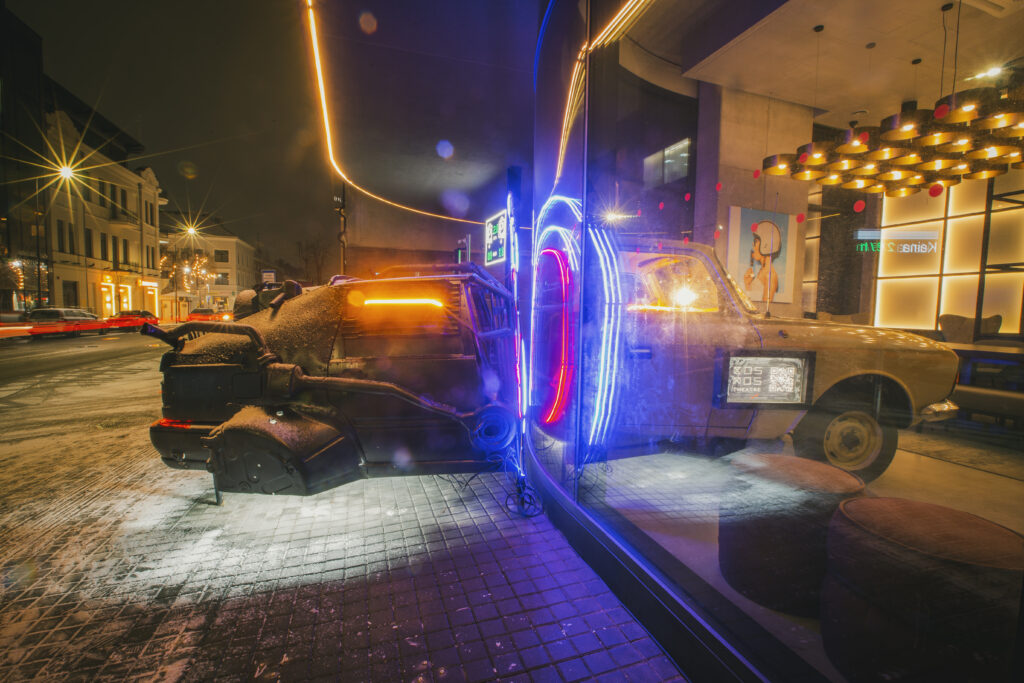BENDING REALITY WITH KOSMOS CAR
KOSMOS CAR is a cycle of 3 artistic installations presenting three different stories of Kaunas European Capital of Culture programme “Memory Office”. The creators of the installations – the theatre of visual experiments “Kosmos Theatre” – see Kaunas as thick with stories, myths, memory and imagination. In three time machines stuck between this and historical realities, between the present, the existent and the time that never existed, the opening event of the Kaunas European Capital of Culture brings to Kaunas the characters of three Kaunas city stories, three projections of historical personalities and the reflections of scientific ideas and moral choices that are invisible to the eyes.
Three concepts of time and the time machines that travel through them, presenting to passers-by not only different stories related to the city of Kaunas, but also allowing us to reflect on the present time. “The narratives of the installations, frozen in their own time concept, like the visual first scene of a film or the opening chapter of an intriguing detective book, are intended first and foremost to arouse the imagination of passers-by, while the passers-by themselves are invited to continue the story. If not in the installation, then in their own lives.” – say the authors of the installations. The series of artistic installations opens during the Kaunas 2022 opening event “Uprising” on 22 January and runs until the end of March 2022.
KOSMOS CAR “FACE TO FACE”

One of the most important thinkers of the 20th century, French and Jewish philosopher Emmanuel Levinas was born in Kaunas in 1906. Due to the upheavals of the First World War, the family moved to the Kharkiv province of Ukraine in 1916 where they live during the Russian coups of February and October 1917. Emmanuel Levinas received his primary education in Russian-speaking schools in Kaunas and Kharkov. In 1920 Levinas and his family returned to Kaunas, in the restored Republic of Lithuania. Just before moving to France to pursue his education Levin studied in a Jewish gymnasium in Kaunas.
Levinas began his philosophical studies at the University of Strasbourg in 1923,[9] and his lifelong friendship with the French philosopher Maurice Blanchot. Levinas became a naturalized French citizen in 1939.[10] When France declared war on Germany, he reported for military duty as a translator of Russian and French.[9] During the German invasion of France in 1940, his military unit was surrounded and forced to surrender. Levinas spent the rest of World War II as a prisoner of war in a camp near Hannover in Germany. Meanwhile, his parents and brothers was killed in Kaunas during the Holocaust.
During his student years E. Levin was published his work in Lithuanian language, but after the Holocaust his connection to Lithuania was marked by a painful loss. In 1961, at the age of 56, E. Levin published “Totalitarianism and Infinity” and became one of the mains thinkers in French philosophy. Levinas derives the primacy of his ethics from the experience of the encounter with the Other. For Levinas, the irreducible relation, the epiphany, of the face-to-face, the encounter with another, is a privileged phenomenon in which the other person’s proximity and distance are both strongly felt. “The Other precisely reveals himself in his alterity not in a shock negating the I, but as the primordial phenomenon of gentleness.” At the same time, the revelation of the face makes a demand, this demand is before one can express, or know one’s freedom, to affirm or deny. One instantly recognizes the transcendence and heteronomy of the Other. Even murder fails as an attempt to take hold of this otherness.
“After the Second World War, after the horrible consequences left by totalitarian regimes, after the seemingly complete undermining of humanism and humanistic values, Levinas finds a way, finds the words to reassert the importance of ethics”, – philosopher, founder of the Emanuel Levinas Centre, VDU associate professor dr. Viktoras Bachmetjevas
KOSMOS CAR “ANGELS”

Once upon a time there was a girl smiling in a meadow in Kulautuva… Her name was Rosian Bagriansky (Zerner). Her parents Polis and Gerta wanted to save her daughter and thus dug a hole next to the fence of Kaunas Ghetto and pushed Rosian through it to the hands of their former employee Bronė Budreikaitė.
Bronė baptised Rosian giving the girl her own surname. She thus became Irena Budreikaitė or Ira for short. The girl was guarded by the so-called angels – the savers of the Jews of Kaunas, Natalija Fugelavičiūtė, Natalija Jegorova and Lidija Golubovienė who had a farmstead in Kulautuva. Rosian was brought to this town just like most of the children guarded by the angels at the end of war. During those summer days of 1944, a photo of Rosian was taken at Kulautuva. It recently became famous around the world. In 2013, curators of an exhibition for the International Day of Commemoration in memory of the victims of the Holocaust (January 27), chose this photography on purpose. It is a wonderful testament of life in the face the horrors of war and death. Who is this girl, what is her destiny, the organisers of the exhibition knew nothing. And how surprised was Rosian, when she saw her own face in one of the US airports, smiling from a big poster. The same face from the childhood, the picture of which was taken in the meadows of Kulautuva. “I am the child in the photo!” she called and told the curators. “I am a living proof that miracles do happen…”
Helene Holzman recalls her first meeting with Rosian: “There was a six-year-old girl with long brownish hair sitting in the room of Liudmila one day, with a cute nose and dark eyes. /…/ The brave Bronė took her from the barbed fence and here she was, but no one had an idea where she could live. “The child must live” I have paraphrased the words of the old spokesperson to a little girl standing in front of me. But the child did not want to see a strange woman; Regina and the angels had to convince her for a long time for her to give me her hand and go together.”
KOSMOS CAR “MINKOWSKI SPACE”

Hermann Minkowski – well-known German mathematician, physicist and one of the founders of relativity theory. He was born in 1864 in Aleksotas and lived in Kaunas until he was eight years old. He studied at the Kaunas Gubernia Gymnasium (now Maironis Gymnasium). In the second half of the 19th century between Minkowski’s house (Aleksotas) and his school (Kaunas) existed two circular calendars. On the Aleksotas side was the New Gregorian calendar, and on the Russian side, in Kaunas province, the Roman Julian calendar. A difference between them was 12 days, so the one of the future founders of relativity theory would have to go to school 12 days back in time.
Then he was only five Hermann was already mastering all arithmetic operations and helping his father with the bills. He became world-famous at the age of seventeen then he took part in a competition at the Academy of Sciences in Paris, where he win The Academy of Sciences awarded the freshman genius the Grand Prize for Mathematical Sciences.
Minkowski developed geometric number theory and the geometry of quadratic forms, the lattice of geometric integer values, etc. He formulated and began to solve the geometrical problem of the existence of certain convex surfaces. This problem is called the Minkowski problem.
His scientific intuition pinpointed the weaknesses of physics at the time and alerted him to the ideas of Hendrik Lorentz, who had just appeared, and of Einstein, which were the main thrust of the new physics. This helped Minkowski to put forward the hypothesis of the unity of space and time, and to establish the geometrical structure of that unity. He first published these ideas in Cologne in 1908 to natural scientists and physicians.
The initial idea of merging space and time into a unified four-dimensional continuum was the analysis of Lorentz transformations. Minkowski was the first to understand the importance of the idea of Lorentz transformations. He argued that in a four-dimensional world, a point has 4 coordinates: 3 spatial coordinates describe the location of an event, and the fourth the time of that event. This four-dimensional space is called event space, or Minkowski space.
Minkowski formulated the principle of relativity for all physical phenomena: the laws of physics are invariant with respect to Lorentz transformations. He introduced the concept of a four-dimensional force (Minkowski force), etc. His work gave relativity a perfect form and helped it to permeate other branches of physics. Without Minkowski’s ideas, it would have been impossible to develop general relativity.
While he teaching at the University of Zurich Hermann Minkowski was Albert Einstein’s teacher.
A few years before his death, Hermann Minkowski visited Kaunas as a world-renowned scientist.
CREATIVE TEAM
Artists Dovilė Gecaitė and Martynas Lukošius
Light installation Džiugas Šėma, Darius Juknevičius
Concepts by Žilvinas Vingelis
Consultant art historian Dr. Daiva Citvarienė (VDU)
Producer Darius Vizbaras
Special thanks to:
Aistis Lansbergas
Kaunas Garrison Officers’ Club
Kaunas Moxy Hotel
Kaunas Remand Prison
KOSMOS THEATRE is an official partner of Kaunas 2022 European Capital of Culture program. From 2019 working together with its Memory office we research Kaunas heritage, connected with local communities and cultural organizations and established a reality bending experience. Proudly we introduce not only this installation but as well as a mobile application KOSMOS APP with 3 audio-compositional stories to inspire the local residents and visitors to travel in time of Kaunas and meet the most inspiring personas who not only affected locally but has a huge impact for us today,
